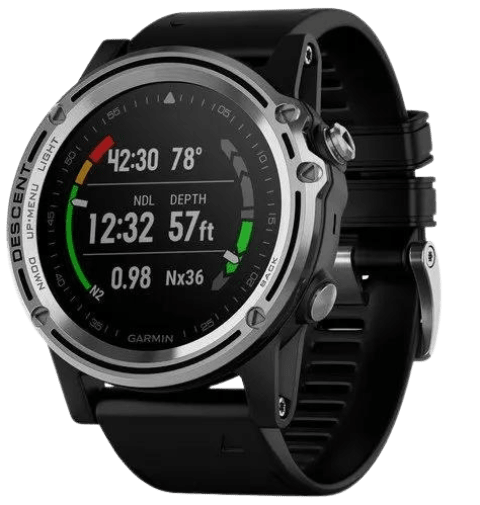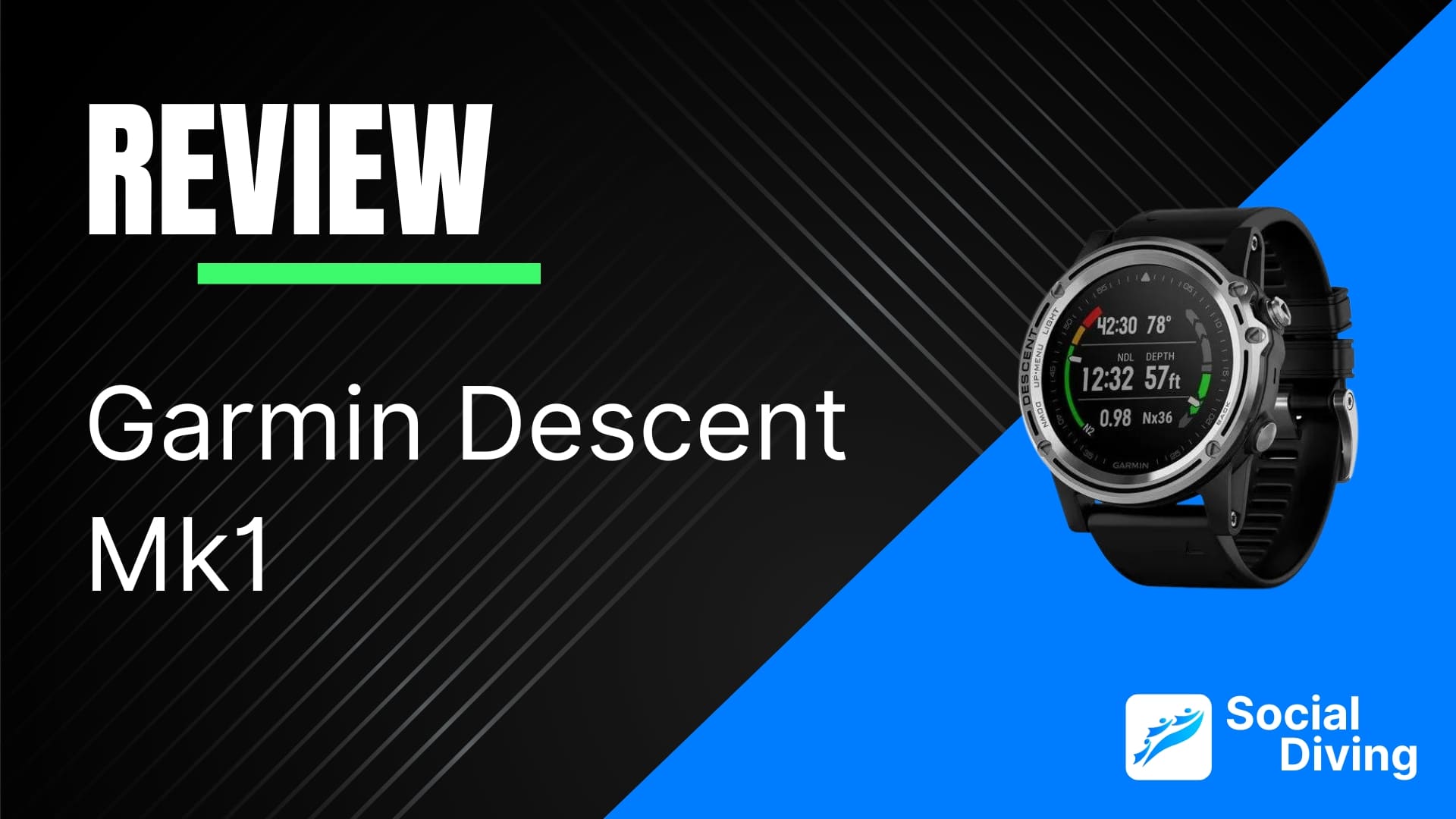The Garmin Mk1 Descent took the world of dive computers by storm and is by far one of the best ones out there.
Combined with extended smartwatch functionalities, the extensive Garmin map, sports and widgets ecosystem and some really innovative features, this is one of the best dive computers ever made.
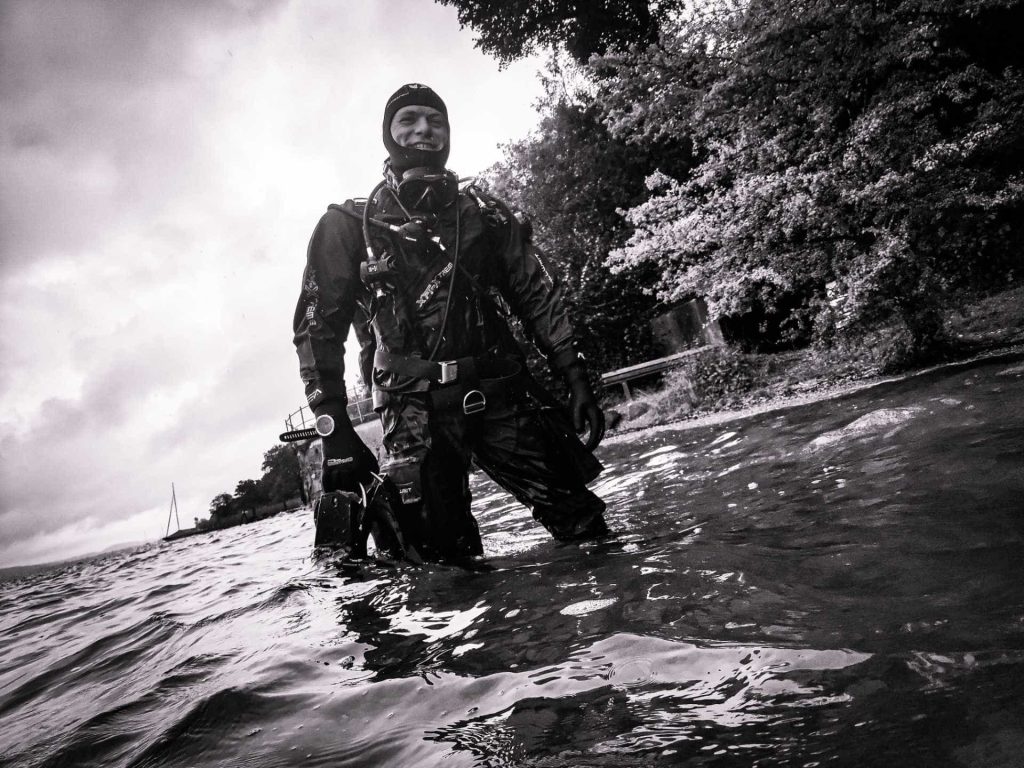
Of course, we also read other opinions online but in the end, nothing beats real world experience. So we took the time for a thorough Garmin Descent Mk1 test and review! Below you find everything you need to know, including features, specs and what we like, and don't like about it.
Review Summary
The first smartwatch turned dive computer is still gold even with newer versions on the market.
Our Rating
What We Like
- Smartwatch & Dive computer in one
- Looks gorgeous
- Versatile
- Great battery life
- Integrates with other Garmin offerings
- Super nice logbook features
Reasons to Avoid
- Looks best on bigger wrists
- No air integration
- Display a little too dim for some
What could be improved
- Air Integration
- Show maximum dive depth during dive
Get it here
First Impression
In a hurry and looking for the gist of things? Here is our review in short. Keep reading for the entire version.
The Garmin Descent Mk1 was the first dive computer released by Garmin and is essentially a smartwatch turned dive computer. It looks absolutely gorgeous and it comes in a standard version, as well as the more expensive Black Sapphire option with a titanium wristband.
Bühlmann Z-16 algorithm, bright display, easy-to-use underwater, a gorgeous compass, a super useful logbook with the Garmin map function integrated and many many many more features make this thing a steal at the current price.
Yes, it isn’t the newest version anymore, but you can find it for under 800$ and that is an amazing value for the money.
Garmin Dive Computers
Garmin launched their dive computers line in 2019 with the Garmin Descent Mk1 and made quite an entrance for themselves.
It takes something to disrupt an entire industry and blow lines of competitors out of the water. However, that’s exactly what they did and keep doing with their latest releases, the Garmin Descent Mk2 & G1 Solar.
The company is best known for its GPS devices and extensive sports watch lines. When they announced they were entering the dive computer market, people were thrilled (myself included).
The Garmin Descent Mk1 is one of the best dive computers out there and introduced a lot of great innovations when it first came out.
The biggest innovation was obviously to combine a smartwatch with a full-blown premium dive computer that also looks amazing.
Gosh, I love this thing. 😃
I used the Garmin Descent Mk1 for about 5 years for anything and everything before switching to the Garmin Descent Mk2i!
Besides being my primary dive computer for basically any dive I do, it is also my daily smartwatch, fitness tracker, and backup logbook.
I love the extensive options for diving, sports, and the connectivity with other apps on my phone.
Specs & Features
| Buttons | 5 |
| Display | Backlit LCD |
| Depth Rating | 100m (330 ft) |
| Memory | unlimited due to app integration |
| Battery | Rechargeable |
| Operating Modes | Single-gas, multi-gas, apnea, apnea hunt, gauge, plan & custom |
| Oxygen Blend | Nitrox, Trimix, Custom |
| Decompression Algorithm | Bühlmann ZHL-16C |
The build
The Garmin Descent Mk1 is a super cool-looking 5-button smartwatch/dive computer that looks very similar to the Garmin flagship model Fenix 6.
It ships in a nice little box and from the first moment you use it, it yells “made for athletes”.
Even with the Shearwater Teric or the Suunto D5, you ultimately get a dive computer, even though they make for nice wristwatches, as well.
However, with the Descent line from Garmin, you get an actual smartwatch that just so happens to have extensive and well-thought-out diving features.
The build quality is great and I find nothing to complain about.

Variations & Color Options
The Garmin Descent Mk1 comes in three versions, the standard one, the more expensive Black Sapphire option with a titanium wrist band, as well as another special edition.
All of them look absolutely gorgeous.
The red special edition might be a little too flashy for some, especially as an everyday watch in business settings, but if this suits your style it’s really fun!
Battery & Charger
The box ships with a special charger that works for all Garmin sports watches.
It’s easy to clip on and off and charges extremely quickly.
Of course, it would be easier if the computer had a USB-C powered charger or a charging pad like other computers, but this is not really a big drawback.
The battery life of the Garmin Descent Mk1 is amazing and it easily lasts a full week and a half in normal mode.
I’d say you can do about three full diving days (3 – 4 dives a day) before charging it again unless you dive in cold water a lot.
In this regard the Descent Mk1 blows the competition out of the water (no pun intended) and it has the best battery life of any computer I have ever used.
The display
The display of the Descent Mk1 is large and easy to read while diving.
It’s a little duller and less bright than the Shearwater Teric, or the Suunto D5, however, once you turn on the backlight it gets better.
All in all, I do think it is too dim for some people and hope that future Garmin dive computers feature brighter displays.
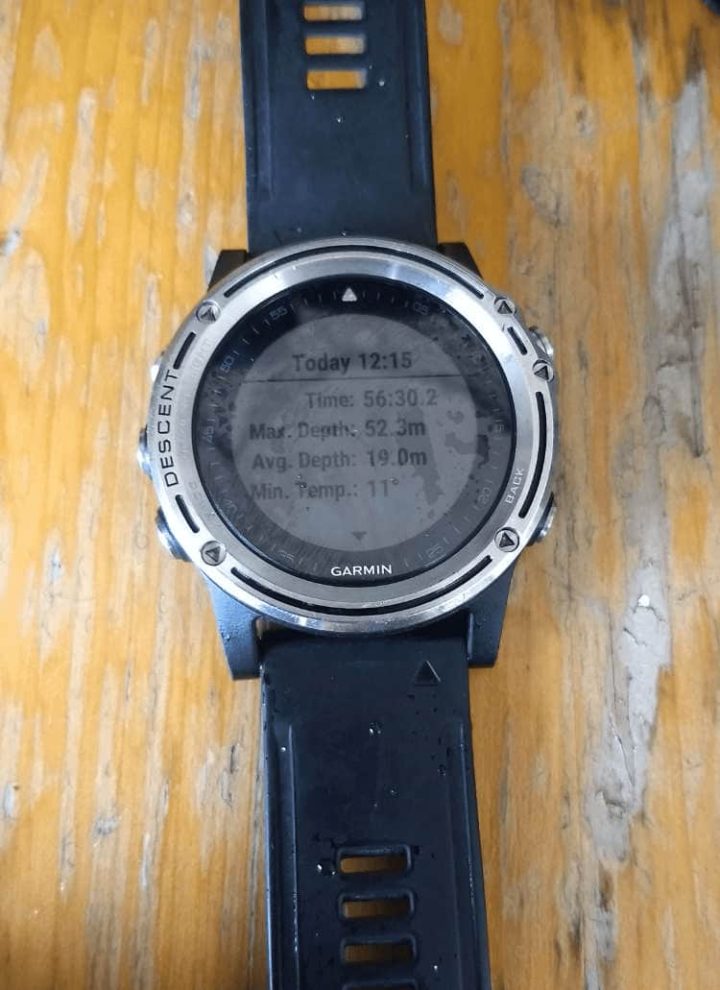
Last but not least, the display is basically uncrackable and even after hitting it against door frames, scuba tanks, and falling on the floor repeatedly, it shows no scratches or signs of wear.
Setup
Setting up and starting to use the dive computer is super simple.
Just turn it on and you can use the default settings right away.
I recommend doing a quick calibration of the compass and altimeter before using it underwater which can be done in about 1 minute.
To receive software updates etc., connect it to your phone and the Garmin Connect app. In 2022, they also released a special Garmin Connect IQ app and Garmin Dive which features advanced log book features and more.
Interface & Navigation
The Garmin features different modes depending on the activity.
Once you get the hang of it, it’s very easy to navigate and the interface is clean and intuitive.
Selecting an activity opens the specific interface for it and gives you lots of customization and options.
As a scuba diver, you will most likely use the “single dive” interface the most.
Before every dive, you get to an intermediate menu that allows you to adjust all settings, including water type, conservatives, gas type(s), and MOD.
During the dive, you can switch through different watch faces to get the information you require.
I like it and it’s well thought-out, however, I would have preferred the option to customize what you see on each face and in what order.
Dive Modes
The Garmin Descent Mk1 comes with 7 different dive modes plus quick settings for Nitrox mode and mixed gas settings:
- Single-Gas (Air, Nitrox or Trimix up to 100% O2)
- Multi-Gas (Nitrox, Trimix or custom up to 100% O2)
- Gauge (Depth, time, resettable stopwatch function)
- Apnea
- Apnea Hunt
- CCR
- Dive plan
You will probably use Single Gas the most which easily allows you to adjust Nitrox and other settings on the fly.
The Descent Mk1 also includes a pretty cool apnea mode that’s useful for freedivers, snorkelers, and skin divers.
There is even an Apnea Hunt mode for those, who like to go spearfishing.
Multi-Gas allows you to set up a detailed decompression plan before your dive and is super useful for technical divers.
You also get a very easy-to-use NDL calculator and dive plan mode that allows gas switches, bottom time calculations, and anything else you could desire.
I have not used the CCR mode during a dive myself, as most rebreathers use specialized dive computers that directly connect to the device, like the Poseidon Mk7.
However, as a casual backup computer, I can see some use for it.
Altitude Mode
Like all other Garmin watches, the Garmin Descent Mk1 includes automatic altitude detection and adjusts the deco algorithm accordingly.
This is super useful and works like a charm when I dive in mountain lakes in the Alps.
It also means you don’t need to remember to set it before diving and everything is done for you.
However, please note that you do need to make sure it is calibrated before starting to use it.
Check if altitude mode works
To confirm that the altitude mode is working, you can check the surface interval screen and check the current N2 saturation. On the mountains, it should rise the higher you go.
Alarms & Notifications
The Garmin Descent Mk1 comes with visual, audio, and vibration alarms.
They are great and there is no way to miss them. You can set up loudness and vibration intensity settings and overall it has one of the best notification and alarm setups, I have ever used.
Dive Log & Data Transfer
Where the Descent dive computer line really shines (and what you ultimately pay a premium price for), is the Garmin app ecosystem that’s attached.
It includes a superb dive log and data transfer is as easy as connecting it to your phone via Bluetooth.
It runs in the background and by the time you’re back on land or home, it is already synchronized.
Hands down, this is so much better than anything else on the market and also looks a lot more modern and appealing than even the Shearwater Cloud.
If you like to have a full overview of your diving and activities data and like to look at pretty charts, graphs, and tables, this is truly a revelation.
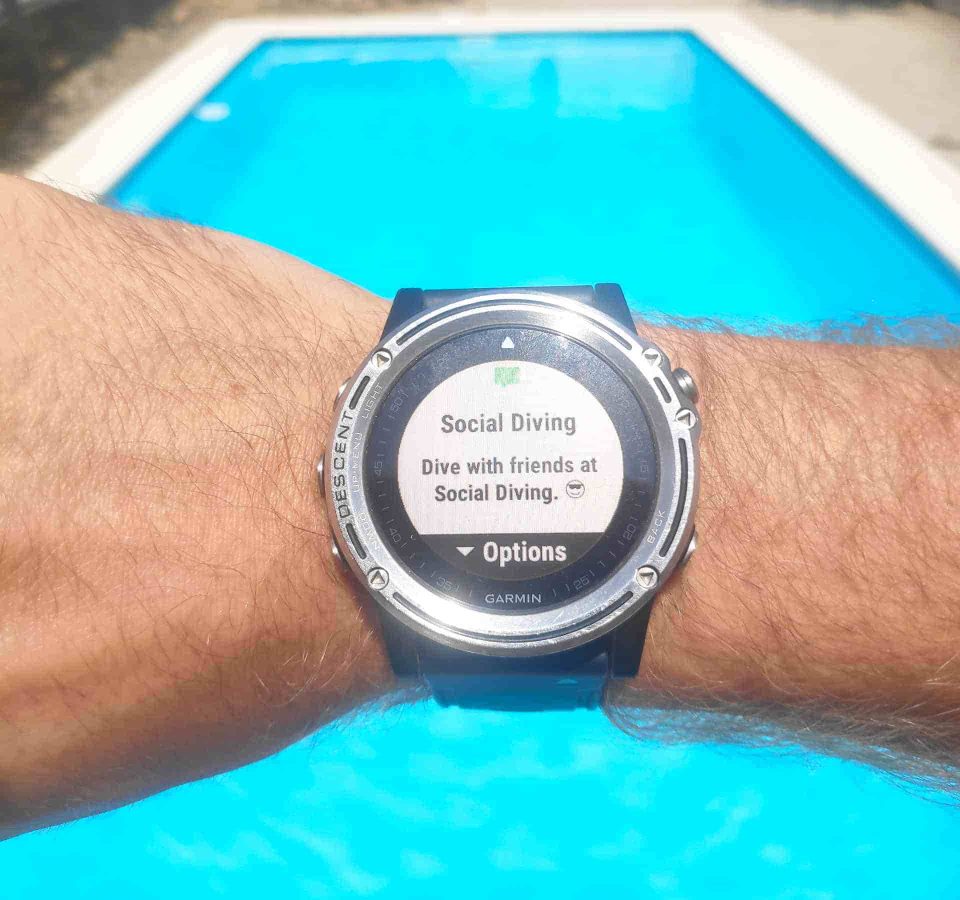
Language Support
The dive computer can be set to near any language, just like the app, and no matter where you are from, you will find a locale setting for you.
Units Support
It is super easy to switch between metric and imperial measurements in the settings.
They can conveniently be changed in the settings menu and by default, the dive computer is set to metric.
Garmin Descent Mk1 Decompression Model
The decompression model is the final thing we must look at when reviewing a dive computer, as the choice of algorithm largely determines its usability and reliability underwater.
While the following analysis might be a little technical, it’s important to know these things as a scuba diver.
Decompression algorithm
The Garmin Descent Mk1 uses the Bühlmann ZHL-16C decompression model that you can find in all Garmin dive computers. It is a modified version using a modern gradient factors approach.
If you have followed my articles for long enough, you know that this is my personal favorite decompression model and my recommendation for all experienced and technical divers.
The Bühlmann model uses 16 body tissue compartments to simulate the on and off-gassing of the human body underwater. Each compartment comes with different rates of Nitrogen on and off-gassing.
Depending on how long these compartments have been under Nitrogen load during a dive, the required decompression time changes.
Gradient factors
Gradient factors make the Bühlmann model adaptable to modern scuba diving.
They essentially allow the user to alter the algorithm and change the acceptable levels of tissue load, and select different levels of algorithm conservatism.
Divers can incorporate decompression stops and durations which differ from the original model to accommodate their dive plan better.
This is done by setting the “conservatism” option to either low, medium or high, which adjusts the gradient factor accordingly.
Experienced divers can even manually set the gradient factor with their custom conservative option.
In practice
The Bühlmann ZHL-16C decompression model is one of the oldest and most commonly applied decompression algorithms used today.
It has been scientifically proven and is trusted by the majority of technical divers around the world.
Using gradient factors means that we can simply switch the conservatism setting to be more liberal (low) or conservative (high), depending on our requirements.
For beginner and intermediate divers, I recommend leaving the setting at default.
The Garmin Descent Mk1 makes use of the best decompression model for scuba divers and based on this, I can wholeheartedly recommend it.
The Garmin Descent Mk1 in practice
Diving wise the Garmin Descent Mk1 is smooth and leaves nothing to wish for.
Several operating modes like scuba diving, freediving, gauge, and a number of different inbuilt gas mixtures are included.
Even if you are a technical diver, the Garmin Mk1 Descent will do a great job.
What I would have liked to see is that it shows me the maximum depth achieved during my dive. While it displays the current depth and the maximum depth AFTER the dive…it doesn’t do so on the in-dive displays.
Video review of the Garmin Descent Mk1
Check out the video below for a short overview and look at the Garmin Descent Mk1 dive computer.
What is missing?
The biggest drawback for many is obviously the lack of air integration. The Garmin Mk2, the successor model to this one, has it though.
What could be better is the features on the display during each dive.
I like to see the maximum diving depth of the current dive while I’m decompressing and the Garmin just doesn’t show it.
Conclusion
If you are looking for a rock-solid smartwatch to take diving, look no further than the Garmin Mk1 Descent dive computer.
It has a ton of features, gets you massive value out of the box and the Garmin app and logbook features are superb.
Bühlmann Z-16 algorithm, bright display, easy to use underwater, a gorgeous compass, super useful logbook with the Garmin map function integrated and many many many more features make this thing a beast.
My favorite little feature is the quick release for the strap that allows you to change the dive computer wrist strap within seconds.
It’s just so cool and smooth.
Alternatives
The most obvious alternatives to the Garmin Descent Mk1 are its successor model, the Garmin Descent Mk2, as well as the almighty Shearwater Teric dive computer.
Garmin Descent Mk1 vs Shearwater Teric
Garmin Descent Mk1 vs Garmin Descent Mk2
If you have any other questions or need advice, leave us a comment below and get the conversation started.
Join the email list to get regular diving, travel, and outdoor tips, tricks, news and our latest deals straight to your inbox!
Where to Buy
